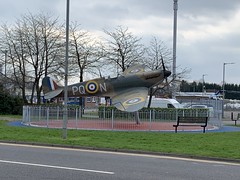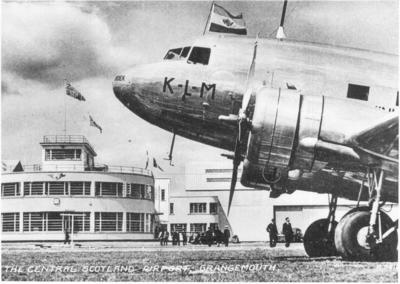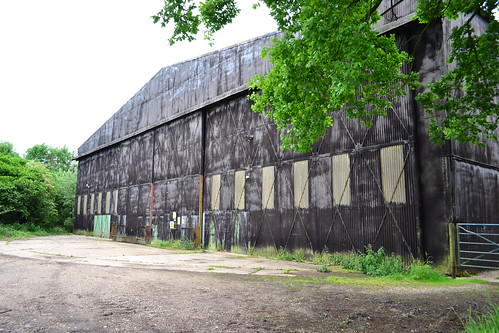Part 2 of this trail saw a range of units arrive at Grangemouth, each one bringing new aircraft and new personnel to this small Scottish site. Some, playing a rather sinister role, eventually move on to leave Grangemouth’s longest standing unit here to see the war out.
58 OTU was initially set up to train night fighters, but was quickly turned into a Spitfire training unit, the purpose to train pilots to fly the Spitfire, many of these trainees would be Polish. In fact, so many were training here that by February 1941, the unit had grown from a small half sized unit to a full unit with in excess of 50 Spitfires and 20 Masters available to the trainees. To help accommodate the aircraft, Grangemouth was paired with a satellite airfield located at Balado Bridge*8 between Edinburgh and Perth.
The training unit would become the longest standing resident unit at Grangemouth and this would set the scene for its future.
The turn of the year though, really saw little change, except the weather got even colder. More rain and fog was joined by frost, and on several days the airfield was closed, its ground simply unsuitable for any flying activity.
Even though the weather was playing havoc, the work that both 58 OTU and the resident 614 Sqn would do in conjunction with the Polish airmen, led an affiliation between 614 and the Polish forces on January 10th 1941; an acknowledgement of the good work that was being done jointly between the two.
March 1941 then brought the news that 614 Squadron would be moving on, to Tranent (Macmerry), perhaps a welcome move as the last few months had seen flying hours drop to around 200 in the day and less than 20 at night. Several accidents had left aircraft badly damaged, crewmen injured and the squadron short of aircraft, it had not been a good year. But by early in the month, the move had taken place and 614 had departed to its new home where it could continue to carry out its sinister role.
With that, the OTU remained the main sole user of Grangemouth until on 10th March 1941, when the Aircraft Delivery Flight Grangemouth was set up. (A month later it would be re-designated 4 Aircraft Delivery Flight). During its lifetime it would operate a number of aircraft: Oxfords, Dominies, Lysanders, Beaufighters, Mustangs and Typhoons. The role of the flight was to ferry aircraft from one location to another, taking new aircraft to new squadrons in support of 13 and 14 Groups.
Delivering aircraft was not without its problems either. On October 2nd, a Hurricane IIA was being transferred by Sgt. Arthur Carl Young of the Flight from Martlesham Heath to Grangemouth. The pilot became disorientated in cloud, and so bailed out leaving the Hurricane to its fate crashing in an area near Goole.
The numbers of trainees at Grangemouth had grown significantly by 1942, so much so, that within 58 OTU a dedicated squadron was formed. Designated as ‘A’ squadron, it was manned by both British and Polish instructors, many of these were hardened veterans including Sqn. Ldr. Henryk Drobinski who had multiple kills and awards to his name.
But Grangemouth would be a multinational training centre, taking pilots from all around the world. The diversity of languages must have been a headache for some, the non- English speaking airmen having to learn very quickly indeed.
Collisions played a large part in the accident roll at Grangemouth, such was the nature of the training programme and those learning to fly the Spitfire, close formation flying being a large part of the syllabus here at the airfield.
In his biography “Challenge in the Air” (William Kimber, 1988), Miroslav Liskutin describes how on a six week course, six of the thirty pilots on his course were killed, a fact they simply lived with.
On April 17th, two pilots were killed when Spitfires R7073 and X4905 collided over Falkirk. One was killed outright, whilst the other died during an attempted crash landing following the incident. Sgt. Siemienczuk (26) along with P/O. Malkiewicz (24), both from Poland, were subsequently buried in Grangemouth Grandsable Cemetery located to the south of the airfield site.
In fact, 1942 saw no less than six collisions or near collisions, all of which resulted in either one or both pilots being killed. All these young men were in their 20s and from countries far beyond Britain’s own borders.
As the demand for training increased and subsequently the numbers of trainees increased, it was decided to increase the length of the main east–west runway by some 300 yards. This would allow for a greater amount of time to land and come to a stop and would allow for faster or larger aircraft to utilise the airfield should the requirement demand. Whilst the necessary work was carried out, operations and training flights continuing unhindered.

Ten months old Marian Edward, held by his mother Audrey Bełc (née Stephenson), receiving his late father’s DFC from Air Commodore W. H. Dunn during an award ceremony at RAF Grangemouth, 21 September 1942. The pilot standing far right in the group in the background is Flight Lieutenant Stanisław Brzeski, also of No. 58 OTU. Note also the former terminal building behind.(© IWM CH 7431)
The extension of the runway however, didn’t prevent further accidents from happening whether in the air or on the ground. Collisions with parked aircraft appear on several occasions, although and perhaps the worst incident, would occur some distance away from the airfield site.
On January 16th 1943, three Spitfires from the OTU were out on a formation flying exercise when they collided with a hillside killing two of the three airmen. It is what happened subsequent to the crash that is perhaps more incredible.
The accident occurred on Saturday 16th January 1943, when bad weather intervened in their flight plans. Initially they were ordered to land at the satellite airfield at Balado Bridge, but an accident there prevented this and so they were diverted to Perth.
In dense mist the three Spitfires X4614 (Ia), AR254 (Ia) and P8276 (IIa) remained in formation resulting in all three colliding with a 648ft high hill known as King’s Seat in the Ochils, 3km north of Dollar, Clackmannanshire. In the collision, two of the three pilots F.O. Hugh Gordon ’Bud’ Reynolds and Sgt. Gordon Murray Duda were both killed instantly. The third pilot, an RAAF airman, Sgt. Vincent P Daly, managed to see the hillside in time and pulled his Spitfire’s nose up at the last minute to reduce the impact on the hillside. As a result, he survived sustaining only a broken leg and other minor injuries.
The crash site being high up in the hills and covered in snow, would not be reached for some time though, and so Daly, even though suffering from a range of injuries (a compound fracture, bruising and cuts to head and body), managed to drag himself down the hillside where he was found two days later by a local farmer.
Daly had managed to use his scarf at the time of the crash, to tie his legs together making a make shift splint to support his broken tibia. He then set off, in freezing conditions, down the hill side toward safety and help. During the decent, he began to contract double pneumonia and suffered severe frostbite to both his toes and his nose – the tip of which he lost.
Once he had been located, Daly was transferred to Larbert Military Hospital, where he made a partial recovery, having to use special shoes and a walking stick to walk. Once out of hospital, he was sent back to RAF Grangemouth, but he never recovered sufficiently to fly again in the RAF. He died in 1969 in his home country, Australia, at the age of just 48 from a heart condition.
Reynolds and Duda were both flying with the RCAF (Duda being an American) and their bodies were eventually found and brought back to be buried at Grangemouth Grandsable Cemetery.
In memory of the airmen and as a lasting tribute a Cairn has been erected at the site (as is common in Scottish mountain crashes) in 2009, and was marked with a flypast by the BBMF Spitfire, Hurricane and Lancaster.
Later that year, on October 5th 1943, 58 OTU would finally be disbanded in name, the aircraft and training programme being reused under the new name 2 Combat Training Wing still here at Grangemouth. For just the next two weeks or so, the unit would operate under this guise, before on the 15th yet another renaming would take place and it would become 2 Tactical Exercise Unit. Continuing to use the Hurricane, Masters and Spitfires, it operated until 25th June 1944, at which point it was seen as surplus to requirements and disbanded for good. This move began the slow and inevitable run down of the airfield.
Between 1944 and 1945 Grangemouth was used by several maintenance units, including both No. 14 MU and No. 243 MU, who used the site after the departure of the OTU to store materials and ammunition. This took the airfield into the late 1940s, at which point there followed a period of limited flying, primarily through a number of RAF gliding schools.
The first of these was No. 6 Gliding school , who were formed here in January 1945 using Cadets, Grunau Baby IIBs and Sedburgh TX.1s. In 1947 a second school, No. 2 Gliding School was also reformed here after being disbanded at Dumfries earlier in the war.
Then on April 1st, 1948, No. 13 Reserve Flying School was formed here at Grangemouth, under the control of Airwork Ltd,. This organisation ran a number of flying training units around the country including two at Scone outside of Perth. 13 RFS used six Tiger Moths and were led by Wing Commander F. Nugent. The School was disbanded a year later in 1949, with almost 200 trainees on their books at various stages.
In 1949, the two Gliding Schools were also amalgamated, the Scone operations continuing at the demise of Grangemouth and absorbing all their equipment.
A third school No. 4 Gliding School then joined Grangemouth in 1951, and eventually all three were absorbed into one under the control of No. 2 Gliding School. A year later the grand terminal building, which had now stood throughout the war, would be destroyed by a major fire, which further helped the demise of the airfield categorically killing any future it may have had.
By 1955, neither Glasgow nor Edinburgh councils had shown any interest in the site as an aviation project, despite the money that had been spent on it previously. Scottish Aviation had also pulled out its resources and so, with all glider schools gone, the terminal building destroyed and no prospect of further flying, the land was put up for sale with an £11m price tag.*9
With that, the airfield was closed. The great dream of civilian aviation at Grangemouth would never materialise again after that. The runways became a proving ground for the young, and new car drivers honed their skills on the concrete paths. By the 1960s, the site was being ripped up and built upon, houses very quickly filled the gaps and the oil refinery took over most of the site. The runway extension, built to allow for longer landings, now holds the Charlotte Dundas Shopping centre along with further housing.
Grangemouth’s humble existence started off as an amazing dream, one that was shattered by the calling of war. A future that was so promising for Scotland’s Aviation industry sadly failed to materialise. Instead, Grangemouth became a training ground for many young men who were far away from their homes in Europe and across the commonwealth. In all, 80 air and ground crew lost their lives while serving at Grangemouth, 60 of those being aircrew. The majority of these lay buried in the local cemetery close to the airfield where they served all those years ago. There are many famous names synonymous with Grangemouth too, many of these were ‘Aces’, highly decorated pilots who achieved many ‘kills’ in their attempt to turn the tide of war. Becoming trainers they also set many trainees off on their long journeys to the war’s end. One such pilot was Neville Duke the test pilot, who went on to achieve great things in the aviation industry.
Whilst elements of the site are still visible, (the two original hangars and traces of one of the runways as part of a Inchyra play park) the airfield leaves few distinguishing features and you would be forgiven for not knowing such a site ever existed close to this growing Scottish town.
In 2013, the cadets of 1333 (Spitfire) Squadron led by Squadron Leader Tom McMorrow, finally saw their plans come to fruition when they were present at the unveiling of their Spitfire memorial outside the original hangar that remains standing today.
Their work and dedication ensures that the memories of those who not only who died here, but served at Grangemouth will go to survive so that we can enjoy the peace we have today.
The full story appears in Trail 64.
Sources and Further Reading (Grangemouth)
National Archives: AIR-27-969-1; AIR-27-1547-1; AIR-27-1550; AIR-27-2073; AIR-27-2079-1; AIR-27-2120-1
*1 Falkirk Herald newspaper website accessed 24/6/23
*2 Delve. K., “The Military Airfields of Britain – Scotland and Northern Ireland“, Crowood Press Ltd. 2010.
*3 During this early part of the Grangemouth’s operation, the unit names became interchangeable, the use of ‘civil’ in 10 CANS being dropped in many situations, and 10 AONS being referred to in the ORBs as early as September.
*4 Secret Scotland website (unsubstantiated)
*5 Aviation Safety Network Website.
*6 Photo from Daily Record newspaper website. Accessed 1/7/23
*7 Photo © Copyright Gordon Brown via Geograph Website Accessed 1/7/23
*8 The Airfields of Britain Conservation Trust placed a marker on the site of Balado Bridge on 8/7/23.
*9 McCloskey, K., “Airwork A History“, The History Press, 2012 (via Google books)





















